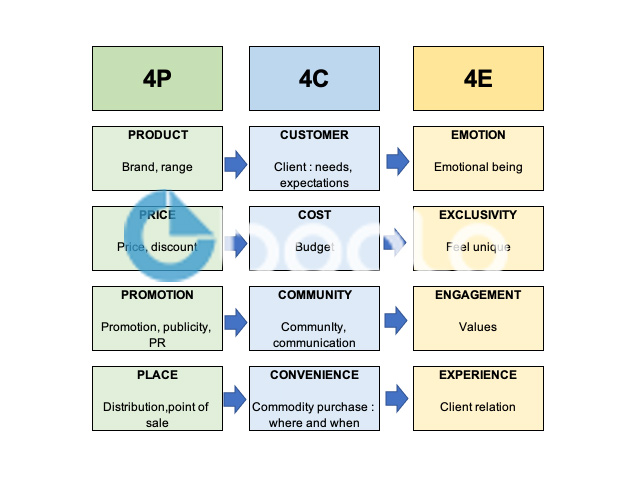Today, the main objective of marketing is to draw consumers' attention to a particular brand or product and to encourage them to buy by increasingly involving the consumer.
In this article, we will talk about the main concepts of the marketing mix, the 4Ps, the oldest of the marketing evaluation tools, such as the 10Ps, the 4Cs, and, finally, the 4Es. We will give the main characteristics of each and their differences.
Pricing policy is very important, especially when competitive pressure is at a peak. The determination of a sale price involves several factors, and it will have an impact on the number of sales and on the decision of buyers at any given moment.
Distribution highlights all the places where it will be distributed. Today physical and digital channels are taken into account to reach as many consumers as possible. Finally, communication determines how the product can be known to consumers. Internet, advertising posters, or more traditional networks such as television and radio. It will also be a question of setting up a message that is more impactful than all those offered by competitors in order to generate more sales.
The company begins to realize that the customer is important and that he must be positioned at the heart of the marketing strategy. Companies have more and more competition, so companies focus on the expectations and needs of customers, in order to put forward products that will please them.
The price is no longer the most important element. The additional services are also taken into account, particularly the after-sales service. Convenience is all about making it easy to buy, like setting up a website or ample parking for customers.
Communication is still important, but the term is slightly different from that encountered in the 4Ps and 10Ps. It is now a question of conveying a message that touches consumers who’s emotions are holding more and more value.
In this article, we will talk about the main concepts of the marketing mix, the 4Ps, the oldest of the marketing evaluation tools, such as the 10Ps, the 4Cs, and, finally, the 4Es. We will give the main characteristics of each and their differences.
The 4Ps (Product, Price, Promotion, Place = product, price, communication, and distribution)
The 4Ps appeared in the 60s, one of the oldest marketing mix models. Over time, it has undergone various changes. The 4P allows companies to put the right product on sale, at the right time, in the right place, and at a price that is in line with market values. This method is used to better understand how to develop a more effective and relevant marketing strategy, with four levels of decision that allow a company to achieve its objectives. The objective is to give the main advantages of the product, its characteristics, why it is competitive, what is the main information to know about it.Pricing policy is very important, especially when competitive pressure is at a peak. The determination of a sale price involves several factors, and it will have an impact on the number of sales and on the decision of buyers at any given moment.
Distribution highlights all the places where it will be distributed. Today physical and digital channels are taken into account to reach as many consumers as possible. Finally, communication determines how the product can be known to consumers. Internet, advertising posters, or more traditional networks such as television and radio. It will also be a question of setting up a message that is more impactful than all those offered by competitors in order to generate more sales.
The 10Ps (the 4Ps plus person, physical evidence, process, partnership, permission, and purple, for purple cow)
The 10P arrived a little later, in the 80s. Other elements are added to the initial 4Ps, such as the person who corresponds to the employees of the company. The proofs are the elements that make it possible to prove that the product is good, quality is good, and that the consumers are satisfied with it. Over time, this evidence has become more and more essential in the minds of buyers, who are becoming both more demanding and more suspicious. The process is about interactions with customers. The partnership represents interactions between companies for a common purpose. The purple cow is concerned with innovations and knowing how to surprise customers.The 4Cs (Customer, Cost, Convenience, Communication)
This model arrived in the 90s, when the customer began to take on increasing importance in the minds of companies and where the competition showed steady increases from year to year.The company begins to realize that the customer is important and that he must be positioned at the heart of the marketing strategy. Companies have more and more competition, so companies focus on the expectations and needs of customers, in order to put forward products that will please them.
The price is no longer the most important element. The additional services are also taken into account, particularly the after-sales service. Convenience is all about making it easy to buy, like setting up a website or ample parking for customers.
Communication is still important, but the term is slightly different from that encountered in the 4Ps and 10Ps. It is now a question of conveying a message that touches consumers who’s emotions are holding more and more value.









